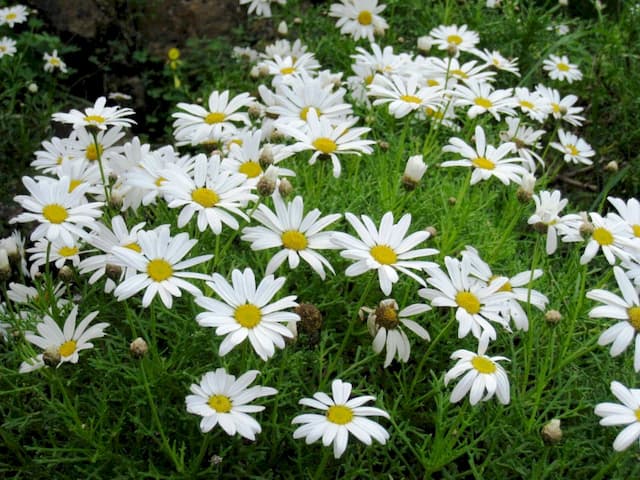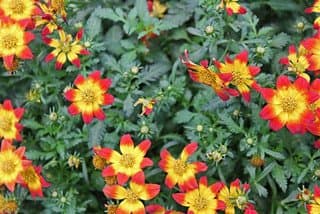Common Knapweed Centaurea nigra

ABOUT
Commonly known as the common knapweed, this plant has a sturdy, tough character with a seemingly untamed presence, giving it an almost thistle-like aspect. However, it is not a true thistle and does not have their characteristic spiky armor. The foliage is lance-shaped, grey-green, and can appear slightly hairy, with leaves arranged spirally on the stem. The stem itself is rigid and can branch out, supporting the flowers. The flower heads are robust, thistle-like, and consist of a cluster of tiny florets grouped tightly together. They sit atop a base of overlapping bracts that can have a slightly purplish tinge. The florets themselves are usually deep purplish-pink, although they can occasionally range into a lighter pink or even white. The appearance of the flower heads gives the impression of a single composite flower and they bloom between early summer and autumn. The common knapweed has a preference for grassy places and can often be seen gracing meadows, roadsides, and edges of fields. This resilient wildflower is a favorite among pollinators such as bees and butterflies, who visit the plant for its nectar and pollen.
About this plant
 Names
NamesFamily
Asteraceae
Synonyms
Black Knapweed, Common Knapweed, Hardheads, Lesser Knapweed, Black Centaury
Common names
Acosta nigra, Calcitrapa nigra, Centaurea agrestis, Centaurea decipiens, Centaurea lugdunensis, Centaurea nemoralis, Centaurea pratensis, Centaurea rivularis, Centaurea sparsiflora, Jacea nigra, Jacea pratensis.
 Toxicity
ToxicityTo humans
Common knapweed, generally, is not known to be toxic to humans. There are no significant toxic effects reported from ingestion of this plant, and it is typically not a concern for human poisoning. However, as with any plant material, individual allergies or sensitivities could potentially cause mild irritation or an allergic reaction.
To pets
Common knapweed is also not known to be toxic to pets. This plant does not contain substances that are generally considered poisonous to animals. As with any non-food plant, ingestion in large quantities could potentially lead to gastrointestinal upset or an obstruction, but toxicity is not a common issue with this plant. Always observe your pets for any signs of distress after consuming any plant material.
 Characteristics
CharacteristicsLife cycle
Perennials
Foliage type
Deciduous
Color of leaves
Green
Flower color
Purple
Height
2 feet (60 cm)
Spread
2 feet (60 cm)
Plant type
Herb
Hardiness zones
3
Native area
Europe
Benefits
 General Benefits
General Benefits- Erosion control: Centaurea nigra has a robust root system that helps stabilize soil and prevent erosion.
- Wildlife habitat: Provides a habitat and food source for various insects, including bees and butterflies.
- Drought resistance: The plant possesses a high tolerance to drought, making it suitable for xeriscaping and arid climate landscaping.
- Aesthetic value: Its distinctive flowers can add visual interest and natural beauty to gardens and wildflower meadows.
- Low maintenance: Requires minimal care once established, reducing the need for watering and fertilization.
- Supports biodiversity: Hosts a range of insect species, thus promoting biodiversity in its natural habitat.
- Pasture improvement: Can be used in grassland management to improve the diversity and quality of pasture.
 Medical Properties
Medical Properties- Anti-inflammatory properties: Centaurea nigra has been traditionally used for its potential to reduce inflammation.
- Diuretic effect: It may promote the production of urine, which can help with urinary tract issues.
- Astringent: The plant has been used for its potential to contract tissues and reduce bleeding.
- Tonic: Historically, it has been used as a tonic to strengthen and invigorate the body.
 Air-purifying Qualities
Air-purifying QualitiesThis plant is not specifically known for air purifying qualities.
 Other Uses
Other Uses- The common knapweed can be used as a natural dye. The roots can provide a brownish-red color for textile dyeing.
- Insect prevention sachets can be made from dried common knapweed flowers to ward off moths from closets and drawers.
- The flowers of the common knapweed are sometimes used in rustic floral arrangements, adding a wildflower aesthetic to bouquets.
- Can be used in companion planting strategies as it attracts beneficial insects that predate on crop pests.
- The seeds of common knapweed are a source of food for birds, making this plant a good choice for wildlife gardens.
- As part of environmental land management, common knapweed is sown to stabilize soil and prevent erosion.
- Its deep root system allows common knapweed to be utilized in phytoremediation to help restore contaminated soils.
- Common knapweed can be used in crafting, such as making natural wreaths and dried flower compositions.
- The stems and fibrous material from common knapweed can be incorporated into paper-making for a textured and rustic aesthetic.
- It is used in meadow restoration projects to encourage biodiversity, as it is a native wildflower in many temperate regions.
Interesting Facts
 Feng Shui
Feng ShuiThe Common Knapweed is not used in Feng Shui practice.
 Zodiac Sign Compitability
Zodiac Sign CompitabilityThe Common Knapweed is not used in astrology practice.
 Plant Symbolism
Plant Symbolism- Perseverance: Centaurea nigra, commonly known as Lesser Knapweed, is known for its hardy and resilient nature, reflecting the quality of perseverance in the face of challenges.
- Independence: Lesser Knapweed grows well in various conditions without much assistance, symbolizing self-reliance and independence.
- Rustic Beauty: With its thistle-like appearance yet beautiful flowers, Lesser Knapweed represents a beauty that thrives in rural and harsh environments, reminding us that there's elegance in simplicity and tenacity.
 Water
WaterFor the Common Knapweed, moderate watering is usually sufficient. It's best to water this plant when the top inch of soil feels dry to the touch. Provide about 1 gallon of water per square yard every week during its growing season, ensuring a deep soak that reaches the roots. Decrease the frequency of watering as the plant becomes established and during cooler months to prevent overwatering. Maintain a consistent watering schedule to promote healthy growth but be cautious not to leave the plant in standing water.
 Light
LightThe Common Knapweed thrives in full sun exposure. It's ideal to place the plant in a location where it can receive at least 6 hours of direct sunlight each day. This plant is adaptable but will perform best and produce the most flowers when planted in a sunny spot.
 Temperature
TemperatureThe Common Knapweed is hardy and can withstand a range of temperatures. It can survive in temperatures as low as 20 degrees Fahrenheit and as high as 90 degrees Fahrenheit. However, for optimal growth, the ideal temperature range is between 60 and 70 degrees Fahrenheit.
 Pruning
PruningPruning the Common Knapweed is done to maintain its shape and encourage new growth. Prune it lightly in the early spring to remove dead or weak stems. For promoting the next season's blooms, cut back the spent flowers. Pruning might be needed once per season or after the main flowering period to keep the plant tidy.
 Cleaning
CleaningAs needed
 Soil
SoilCommon Knapweed (Centaurea nigra) thrives in a well-draining soil mix with a neutral to slightly acidic pH around 6.0-7.0. To create an ideal soil mix, blend two parts loam, one part peat, and one part sharp sand to ensure good drainage and aeration. Regular garden soil amended with organic matter can also support this plant well. Avoid overly fertile or waterlogged conditions.
 Repotting
RepottingCommon Knapweed (Centaurea nigra) does not typically require frequent repotting due to its ability to thrive in less fertile soils. However, if the plant outgrows its container or the soil becomes exhausted, you can repot it into a slightly larger container every 2-3 years in the spring, ensuring minimal root disturbance.
 Humidity & Misting
Humidity & MistingCommon Knapweed (Centaurea nigra) is well-adapted to outdoor conditions and does not require specific humidity levels for growth. It is tolerant of a wide range of humidity conditions found in its natural environment and can thrive in average ambient humidity levels.
 Suitable locations
Suitable locationsIndoor
Place Knapweed in bright light and avoid overwatering.
Outdoor
Plant Knapweed in full sun; water when soil feels dry.
Hardiness zone
3-7 USDA
 Life cycle
Life cycleCommon Knapweed (Centaurea nigra) begins its life cycle as a seed, often germinating in the autumn or spring when conditions allow. Seedlings emerge, developing a rosette of leaves close to the ground and a deep taproot through the first year, which is its vegetative stage. After the first year, or sometimes after a period of dormancy, the plant transitions to the reproductive stage, sending up flowering stems typically in the second year. Flowering occurs between June and September, with thistle-like purple or occasionally white flower heads attracting a variety of pollinators. After pollination, seeds are produced, which are then dispersed by wind, animal movement, or other means. Common Knapweed is a perennial plant, so this cycle of vegetative growth and flowering can repeat for several years once the plant reaches maturity.
 Propogation
PropogationPropogation time
Spring to Summer
The Common Knapweed (Centaurea nigra) is typically propagated through seeds. The best time to sow the seeds is either in the spring or in the autumn. To propagate Common Knapweed using seeds, you should scatter the seeds onto a prepared seedbed that has been cleared of weeds and has a fine tilth. After scattering, lightly cover the seeds with soil to ensure that they are not more than a quarter inch deep. The seeds need light to germinate, so they should not be buried too deeply. Water the area gently to moisten the soil without causing the seeds to wash away. Seedlings usually appear within a few weeks, and robust plants develop over several months. It's important to keep the seedbed moist but not waterlogged during germination and early growth.




![Marigold [PowerDaisy Tango]](/_next/image?url=https%3A%2F%2Fplants-admin.emdemapps.com%2Fimages%2Fplants%2F%2Fimages%2F604b567a0b366.png&w=640&q=75)




